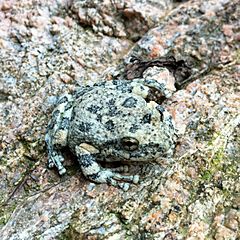California tree frog facts for kids
Quick facts for kids California tree frog |
|
|---|---|
 |
|
| Scientific classification | |
| Kingdom: | |
| Phylum: | |
| Class: | |
| Order: | |
| Family: | |
| Genus: |
Pseudacris
|
| Species: |
P. cadaverina
|
| Binomial name | |
| Pseudacris cadaverina (Cope, 1866)
|
|
| Synonyms | |
|
Hyla cadaverina |
|
The California tree frog (Pseudacris cadaverina) is a small, fascinating frog. It lives in parts of California and Mexico. These frogs are experts at hiding. Their skin often looks like stones, helping them blend in. This special skin is rough and bumpy, like warts. They also have webbed feet, which are great for swimming. California tree frogs can grow to be about 2 to 5 centimeters long. That's about the size of your thumb!
Contents
California Tree Frog
The California tree frog is a type of tree frog. It is known for its amazing ability to blend into its surroundings. This frog is not a true tree frog, but rather a chorus frog. Chorus frogs are usually small and have a distinct call. The California tree frog was first described in 1866.
What Does It Look Like?
California tree frogs are usually gray, tan, or light brown. Their skin has dark spots and blotches. This coloring helps them look like rocks or dry leaves. Their rough, warty skin also helps them hide. It makes them look like the bumpy surfaces of stones.
These frogs have special webbed feet. The webbing helps them move easily in water. It also helps them climb on wet rocks. Their eyes are large and often have a golden color. This helps them see well, especially at night.
Where Do They Live?
California tree frogs live in the southwestern United States and northwestern Mexico. You can find them in California and Baja California. They prefer areas near water. This includes streams, rivers, and rocky canyons. They like places with plenty of rocks and boulders. These rocks give them good places to hide.
They are often found in chaparral and woodland areas. These habitats have dry summers and mild, wet winters. The frogs stay close to water sources all year. This is important for their survival.
What Do They Eat?
California tree frogs are carnivores. This means they eat other animals. They mostly eat small invertebrates. Their diet includes insects like flies, beetles, and spiders. They are active hunters, especially at night.
They wait patiently for prey to come near. Then, they use their long, sticky tongues to catch their meal. Their diet helps control insect populations in their habitat.
Life Cycle and Reproduction
The reproduction of California tree frogs usually happens in spring. This is when the weather gets warmer. Male frogs make calls to attract females. Their calls sound like a soft, raspy croak.
Female frogs lay their eggs in water. They attach the eggs to plants or rocks. The eggs hatch into tadpoles. Tadpoles are young frogs that live in water. They have gills to breathe underwater. Tadpoles eat algae and small bits of plants.
As they grow, tadpoles slowly change. They develop legs and lose their tails. This process is called metamorphosis. After a few weeks or months, they become tiny froglets. These young frogs then leave the water. They begin their life on land, just like adult frogs.
How Do They Behave?
California tree frogs are mostly nocturnal. This means they are active at night. During the day, they hide under rocks or in cracks. This helps them stay safe from predators. It also keeps them cool and moist.
They are very good at camouflaging themselves. When they feel threatened, they stay very still. Their stone-like appearance makes them almost invisible. This is their main defense mechanism. They are not known to be aggressive.
Protecting the California Tree Frog
The California tree frog is currently listed as a species of "Least Concern." This means their population is stable. However, like many amphibians, they face threats. These threats include habitat loss and pollution. Water quality is very important for their survival.
Protecting their natural habitats helps these frogs. Keeping streams and rivers clean is crucial. This ensures they have safe places to live and reproduce. Learning about these frogs helps us appreciate them. It also encourages us to protect their environment.
See also
 In Spanish: California tree frog para niños
In Spanish: California tree frog para niños

